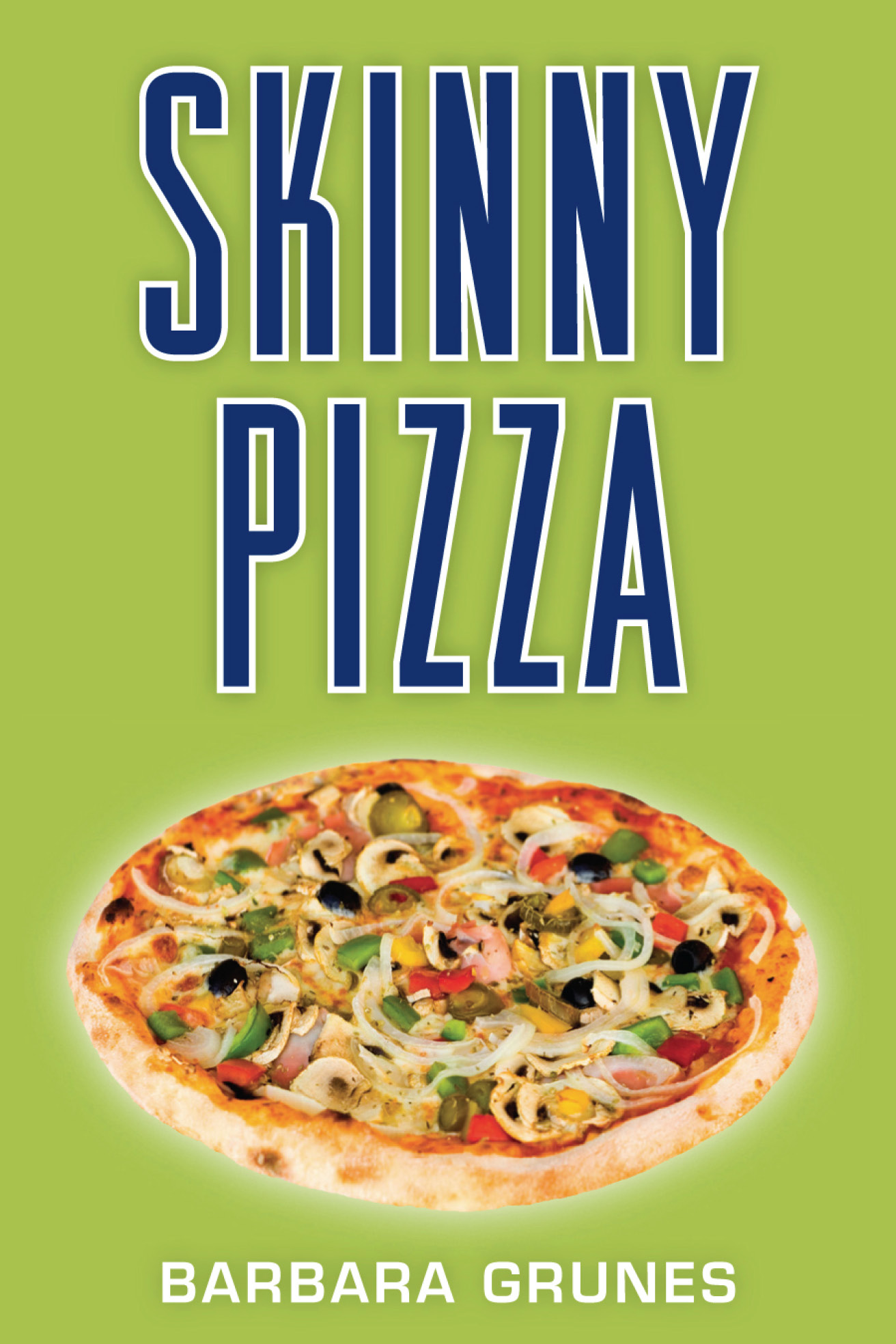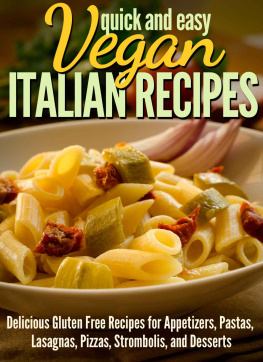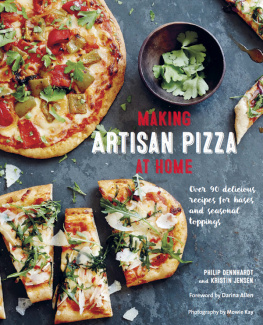
Skinny Pizza
Barbara Grunes
Copyright 1996 by Barbara Maniff Grunes.
All rights reserved, including the right to reproduce this book or portions thereof in any form, including any information storage or retrieval system, except for the inclusion of brief quotations in a review.
Editorial and production: Bookcrafters, Inc., Chicago
Nutritional analyses: Linda R. Yoakam, M.S., R.D.
Art direction: J oan Sommers Design, Chicago
Other titles in the Surrey Cookbooks Series:
Skinny Beef
Skinny Chicken
Skinny Chocolate
Skinny Cookies, Cakes & Sweets
Skinny Grilling
Skinny One-Pot Meals
Skinny Pasta
Skinny Potatoes
Skinny Sandwiches
Skinny Sauces & Marinades
Skinny Seafood
Skinny Soups
Skinny Spices
Skinny Vegetarian Entres
Special thanks to Dorothy Grunes, Sharron Robbins, and Jane Tougus
Ebook edition 1.0 June 2012
Ebook ISBN-10 1-57284-401-9
Ebook ISBN-13 978-1-57284-401-8
Agate Digital is an imprint of Agate Publishing. Agate books are available in bulk at discount prices. For more information visit agatepublishing.com.
Why Skinny Pizza?

Pizza is perceived by many Americans as a special-occasion food. As with many such self-indulgent foods, pizza can be high in calories, fat, and cholesterol. But it doesnt have to be. This book will show you how to prepare great-tasting skinny pizzashealthful pizzas with all the flavor and texture connoisseurs demand!
Fat contains more calories per gram than either carbohydrates or protein. Our skinny pizza recipes eliminate unnecessary fatand calories.
Health experts have suggested that we be especially conscientious about limiting saturated fat consumption. Thus, the recipes in this book use only olive oil and canola oil, both monounsaturated fats. Actually, there is some scientific evidence linking monounsaturates to lowered blood cholesterol levels.
Remember that cholesterol is found only in foods of animal origin not in plant foods such as fruits, vegetables, grains, and herbs and spices. Delicious skinny pizzas can be made with no meat and with low-fat or even fat-free cheeses.
Dont save pizza just for that special occasion. Easy, healthy, tasty skinny pizzas are a wholesome, delicious, anytime choice. And this health-sensitive cookbook will show you exactly how to make them.
Did You Know?
- Pizza cheeses are a source of protein, calcium, vitamins, and minerals.
- Pizza crust is made up of complex carbohydrates.
- Pizza can be loaded with an array of vegetablesall low in calories and high in vitamins and fiber.
- All four food groups are contained in one slice of pizza: grain, vegetable, dairy, and meatproviding a virtually complete meal.
Introduction

Pizzas explosion in popularity in the United States in recent decades must be one of the worlds least kept secrets. It would be a rare American indeed who has not savored pizza in one of its myriad forms. In fact, the average American devours 7.5 pizzas each year; remember, this figure includes every man, woman, child, and baby in the nation. Pizza is rapidly closing the gap on hamburgers as Americas number-one choice when eating out, and that does not include the millions of store-bought frozen pizzas, deli-prepared pizzas, and homemade pies.
Ironically, despite this incredible surge in popularity, pizza is still considered by many to be a junk food. It is the purpose of this book to debunk that mythical belief and to provide recipes and tips that will allow the home-kitchen cook to create a wide variety of pizzas that have nutritional value, superior dietary character, and, especially, great taste.
Skinny pizza means lower-calorie, lower-fat, and lower-sodium pizza. However, two of the real joys of homemade pizza are the simplicity of preparation and the zesty, exquisite combinations of tastes. I have created and tested the recipes in this book with the consistent goal of combining both of those conceptshealthier pizzas that retain traditional tastiness and offer ease of preparation.
It has been my intention to design pizza recipes that everyone can enjoy, from the most finicky child to the omnivorous teenager, from the increasingly health- and nutrition-conscious adult to those with dietary limitations.
Skinny Pizzas does include a number of classic pizza recipes. I have, however, focused upon the use of skinny ingredients and preparation methods: thinner crusts, using lower-fat and lighter bases such as pita bread, whole-wheat flours, and even large crackers; low-sodium sauces and fat-reduced cheeses; and, finally, many unique healthy topping options such as nuts, fruits, and unusual yet readily available vegetables and ethnic foods.
I have also included dessert and party pizzas and a Grilled Pizza Party.
Having lived for many years in Chicago, the city of pizza, I have experienced the pleasure of consuming my share of incredibly rich Chicago-style pizzas. I must say, however, that during the development of this book, I have become enchanted with the concept of skinny pizza. Skinny pizzas retain the rich deliciousness of traditional pizza while being much more in tune with the emerging American diet. I am convinced that you, too, will be equally impressed by the taste, the flexibility, and the increased nutritional and dietary qualities of the recipes included in this book.
Viva la Skinny Pizza!
Before we get into the recipes, lets take a brief look at the history of pizza and at some facts about pizza as a full-meal food source.
A Brief History of Pizza
The exact origin of pizza is open to dispute. Some culinary historians even claim that pizza had its origin during the Neolithic Age, probably as a mixture of foods served with or on wheat flour crackers or bread. Pizza, as we Americans know it, evolved in Italy, probably around A.D. 1000 when the word picea or piza first appeared in the dialect of Naples. This early pizza referred to a round-shaped dough that was covered with flavorful ingredients such as olive oil, cheese, and bits of chopped vegetables and fish. Tomatoes, which are native to America, did not become part of the pizza formula until the sixteenth century, many years after the arrival of Columbus in the New World.
Pizza, prepared and sold in open stands was popular in Naples for decades, and it became a favorite of kings and queens. It was offered to guests by the Bourbons at their receptions at the Palace of Caserta northeast of Naples. King Ferdinand IV had pizza cooked in the ovens of the famous porcelain factory of Capodimonte, and Queen Maria Carolina, sister of Marie Antoinette, had ovens built in the forests so she could enjoy pizza while hunting.
In 1889 the most truly recognizable ancestor of modern American pizza was created by the great pizzeria owner Don Raffaele Esposito in honor of Queen Margherita, consort to King Umberto I of Italy. This wonderful delicacy, known even today as pizza alia Margherita, combined the colors of the Italian flag: red tomatoes, white mozzarella cheese, and green basil.
Italian immigrants to the United States brought pizza with them during the late 19th century. Pizza grew in popularity, spreading from Italy at the end of World War II, and becoming ever more popular in America.















